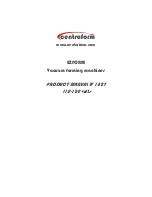
12
| English
1 609 929 S83 | (1.7.09)
Bosch Power Tools
When the base plate cannot be adjusted or only
with difficulty after opening the clamping lever,
turn the thumbwheel in the
“–”
direction.
Sawdust Blower Device
With the air jet of the sawdust blower device
8
,
the cutting line can be kept free of dust and
chips.
Switching on the sawdust blower device: For
cuts in materials with high removal rate, such as
in wood, plastic, etc., push the switch
8
to posi-
tion
“I”
.
Switching off the sawdust blower device: For
cuts in metal and when a dust extraction system
is connected, push the switch
8
to position
“0”
.
Starting Operation
f
Observe correct mains voltage! The voltage
of the power source must agree with the
voltage specified on the nameplate of the
machine. Power tools marked with 230 V
can also be operated with 220 V.
Switching On and Off (GST 120 E)
To
start
the power tool, push the On/Off switch
3
forwards.
To
switch off
the machine, push the On/Off
switch
3
toward the rear so that the
“0”
is indi-
cated on the switch.
Switching On and Off (GST 120 BE)
To
start
the machine, press the On/Off switch
3
and keep it pressed.
To lock the
pressed
On/Off switch
3
, press the
lock-on button
2
.
To
switch off
the machine, release the On/Off
switch
3
. When the On/Off switch
3
is locked,
press it first and then release it.
Controling the Stroke Rate (GST 120 BE)
Increasing or reducing the pressure on the
On/Off switch
3
enables stepless stroke-rate
control of the switched-on machine.
Light pressure on the On/Off switch
3
results in
a low stroke rate. Increasing the pressure also
increases the stroke rate.
When the On/Off switch
3
is locked, it is not
possible to reduce the stroke rate.
Presetting the Stroke Rate
With the thumbwheel for stroke rate preselec-
tion
4
, the stroke rate can be preset and
changed during operation.
The required stroke rate is dependent on the
material and the working conditions and can be
determined by a practical trial.
Reducing the stroke rate is recommended when
the saw blade engages in the material as well as
when sawing plastic and aluminium.
After longer periods of work at low stroke rate,
the machine can heat up considerably. Remove
the saw blade from the machine and allow the
machine to cool down by running it for approx.
3 minutes at maximum stroke rate.
Working Advice
f
When working small or thin work pieces, al-
ways use a sturdy support or a saw table
(accessory).
While working, hold the machine by the handle
16
and guide it alongside the desired cutting
line. For precise cuts and quiet running, guide
the machine additionally with the other hand by
the plastic cap
1
.
Contact Protector
The contact protector
13
attached to the casing
prevents accidental touching of the saw blade
during the working procedure and may not be
removed.
Plunge Cutting (see figures I – J)
f
Plunge cuts may only be applied to soft ma-
terials, such as wood, gypsum plaster
boards, etc.!
Use only short saw blades for plunge cutting.
Plunge cutting is possible only with the mitre an-
gle set at 0°.
1–2:
Low stroke rate
3–4:
Medium stroke rate
5–6:
High stroke rate
OBJ_BUCH-655-004.book Page 12 Wednesday, July 1, 2009 5:13 PM













































